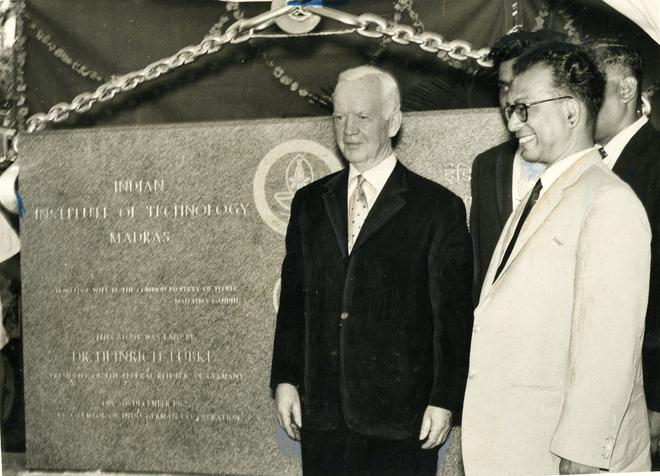
On the afternoon of July 11, 1964, the air in the bowl-shaped amphitheatre at the Indian Institute of Technology-Madras (IIT-M) crackled with nervous energy. The institute had successfully produced its first batch of qualified scientists and engineers. After delivering the convocation address, President S. Radhakrishnan awarded degrees to 92 graduates and 15 postgraduates. This is how a report in The Hindu, published on July 17, 2014, marking the Golden Jubilee of the IIT-Madras first batch of graduates, described the occasion. Today, the 65-year-old IIT, standing on a sprawling campus in the heart of Chennai, stands testimony to the efforts of visionary leaders who sowed the seeds of this prestigious higher educational institute nearly a decade after Independence.
Congress veteran C. Subramaniam, in his memoir, Hand Of Destiny (Volume-I The Turning Point, Chapter 34), published by Bharatiya Vidya Bhavan, said that it was during the 1950s that the Government of India took steps to establish Indian Institutes of Technology, with the first one at Kharagpur. The steps to establish an IIT with foreign collaboration started in 1956, during the four-day official visit of Prime Minister Jawaharlal Nehru to West Germany. A report published in The Hindu on July 18, 1956, based on a communiqué issued at Bonn at the end of talks between Nehru and Chancellor of West Germany Konrad Adenauer, said, “The two Heads of Government agreed that in co-operation between the two countries a technical teaching institution is to be set up in India for which the Federal Government will make available teaching equipment.”
Rush among southern States
Soon after the announcement that the institute with German collaboration would be established in the southern part of India, Andhra Pradesh, Karnataka, Madras, and Kerala pressed their claim to hosting the institute. A meeting of the four Chief Ministers was convened in Madras to decide this issue.
Subramaniam, who was then Education Minister in the government of K. Kamaraj, said in his memoir that at the meeting, Andhra Pradesh Chief Minister Neelam Sanjiva Reddy, who later became the President, opposed the proposal to locate the institute in Madras. “Sanjiva Reddy pleaded for its location in Hyderabad and strangely suggested that if that was not feasible, Kerala could have it. I was surprised at his attitude because he was earlier a Minister in the composite Madras State and I had naturally expected that he would throw his weight in favour of Madras.”
At this juncture, when the Chief Ministers were not able to arrive at a consensus on the location of the proposed IIT, it was Subramaniam who suggested getting the opinion of experts. “I suggested that perhaps the location of the institute, like the IIT, should not be a political decision. It should be a decision taken by technical experts after taking into consideration various technical factors. This was agreed to, and the technical experts favoured Madras,” he noted.
Land identification
The West German experts wanted nearly 1,000 acres of land to establish the institute in Madras. Subramaniam came up with the idea of establishing the institute at Guindy, where the Raj Bhavan was located on 1,500 acres, most of which was maintained as forestland. “I took up the matter with Governor Sri Prakasa and persuaded him to release 750 acres. The Governor readily agreed. Then, we wanted another 250 acres adjoining this land.”
Subramaniam and other officials surveyed the adjoining area and found 5,000 acres of vacant land. The cost at that time was ₹5,000 an acre. Subramaniam, who was also the Finance Minister, ordered the acquisition of the entire vacant land available in that area. “This was criticised. One of the points made was that unnecessary investment was being made in vacant land. Today, this area is a constellation of so many technical and educational institutions,” he noted.
Workshop and library
Answering a question in the Lok Sabha on December 2, 1958, on the establishment of the institute in Madras, Union Minister for Scientific Research and Cultural Affairs Humayun Kabir said the Federal Republic of Germany agreed to provide a workshop, laboratory equipment, and a library, whose total value did not exceed ₹1.8 crore; 20 German professors to serve at the institute for four to five years; four German foremen for the workshops at the institute for a period of not less than two years; and facilities for the training of 20 Indian teachers in Germany.
The Minister also replied that the construction of buildings would start as soon as the detailed plans were ready and it would take about five years for all the buildings of the institute, staff quarters, and hostels to be completed. Efforts were being made to admit the first batch of students in July-August 1959.
Inauguration
The IIT-Madras was inaugurated by Kabir on the temporary campus at A.C. College of Technology at Guindy on July 31, 1959. A. Lakshmanaswamy Mudaliar, Vice-Chancellor of Madras University, assumed office as the first Chairman of the Board of Governors of the IIT-Madras and B. Sengupta as the first Director of the institute.
The Hindu had reported that while the construction of the buildings would commence shortly on the 600-acre site at Guindy, arrangements were made to start the first batch of degree courses at present at the A.C. College of Technology. “One hundred and twenty students, selected on an all-India basis on merit, have been admitted to the institute. Three professors and two workshop experts from Germany have also arrived to assist in organising and conducting the courses.”
Another report in The Hindu on December 4, 1962, said that the President of the Federal Republic of Germany, Heinrich Lübke, laid the foundation for the IIT at Guindy the previous day. He described the project as a manifestation of the close cooperation between West Germany and India in the field of technical learning. In later years, the institute was gradually shifted to the present campus.







